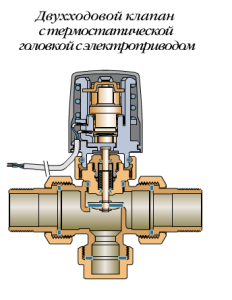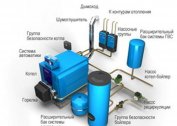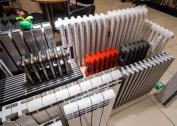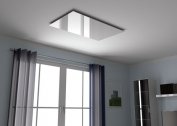A professionally planned heating system is a complex to create a comfortable temperature in a residential building, commercial and industrial building. In addition to the required elements of the boiler, radiators and pipes, it must include control components. They received the general name valves for heating systems: shut-off, regulating. Without it, the work of an autonomous complex would not have been possible.
Requirements for the material of manufacture of valves
At the first stage of familiarization, it is necessary to find out which fittings for heating systems perform certain functions. Its general purpose is to regulate the flow of the coolant, the distribution along the contours of the system, as well as a decrease or increase in volume.
Depending on the design, the fittings for heating are divided into two types - shut-off and regulating. Each of them has a specific functional load that directly affects the operation of the entire system.
Stop valves
Designed for forced reduction or final stop of the coolant in a certain section of the pipeline or radiator. Traditionally, cranes or gate valves with various types of structures are used for this. When choosing a particular model, first of all, it is necessary to pay attention not only to the geometric parameters of the connection, but also to the material of manufacture. Qualitatively made shut-off valves for heating must withstand critical temperature conditions and maximum pressure. These parameters must be indicated in the passport or directly on the product body.
Control valves
It is necessary to ensure the security of the system. First of all, the control valves for heating stabilizes the pressure inside the pipes, and also regulates the degree of heating of water by mixing cold and hot flows. In addition to the above requirements for heating shutoff valves, you can add the degree of adjustment of the response or mixing of flows, as well as the possibility of automatic operation. That is why some models are equipped with electronic control.
As for the material of manufacture - most often used brass, bronze or malleable cast iron. The fittings for steel heating radiators are rarely different, since the properties of this material are little adapted to the operating conditions in a system with hot water.
On sale you can find combined units of fittings for heating, in which 2 or more elements are installed. Installation of such models is much simpler than each type of reinforcement separately.
Heating shutoff valves
Heating fittings for regulating the volume of fluid flow in pipes is one of the main elements of any heating system. It is installed at those points of the highway where it is necessary to partially or completely limit the flow of water.
Almost every manufacturer provides a catalog of fittings for heating. It is necessary for the correct choice of a particular model. The main parameters are.
- Diameter of inlet and outlet nozzles. Required to connect to the trunk. It is important that in a fully open state the tap or valve does not limit the speed of movement and the volume of coolant;
- Degree of regulation. The accuracy of decreasing or increasing the pressure of water depends on this.Ball valves are used to quickly cover the flow, and with the help of wedges it is possible to smoothly control the flow of coolant in the pipes;
- Possibility of installing an automatic regulator of the degree of opening of valves for heating.
Often, cranes and valves are used to complete the heating system. In addition to the correct installation and selection of a specific model for operational qualities, it is necessary to know the device of these elements of the heating system.
Heating taps
The use of faucets as fittings for radiators or the creation of points of overlap of pipelines is due to their relatively simple design and the ability to choose from several model options. Depending on the method of regulating the flow of water, the following types of taps are distinguished.
- Ball. Inside the structure is a ball with a through hole. As you turn the knob, the diameter increases or decreases. This shut-off valve for heating radiators is characterized by the ability to quickly overlap - just turn the lever 90 degrees. However, using such a crane is difficult to perform smooth adjustment;
- Stock. As a locking mechanism, a rod with a rubber or ceramic gasket is used. For complete closing and opening, it is necessary to make several full turns of the handle. Such shutoff valves for heating are used to precisely control the volume of flow of the coolant.
Installation and selection of cranes should be carried out only in agreement with the operating parameters of the system.
Carefully select gaskets for installation. In systems with antifreeze, it is recommended to mount paronite, as they are least susceptible to deformation.
Heating valves
Structurally, they are similar to the above stock cranes. The main difference is their size is much larger. The shape of the internal channels is also changed - the wave structure provides protection against significant pressure drops. This ensures the integrity of the stem and complete sealing of valves for closed heating systems. Similar mechanisms are installed in central heating pipelines, where the diameter of the pipes exceeds 100 mm.
Heating control valves
It is intended for the control operation of the heating system as a whole or in a specific area. It depends on the design and operational parameters. Consider the most popular and mandatory models for installation.
Mayevsky crane
If the heating of a certain radiator has significantly deteriorated, there is a high probability of an air plug. To prevent overheating of the coolant, it is necessary to install Mayevsky taps on each of the heating devices in advance.
This heating control valve is a needle valve which, when closed, is completely sealed. It is installed on the upper radiator pipe, in case of air congestion it helps to eliminate them. To do this, use a wrench or a screwdriver to loosen the pressure on the curtain. This is done until the characteristic sound of the outgoing air is heard. The procedure ends only when the coolant begins to flow.
Heating radiators are often equipped with shutoff valves. This point needs to be clarified at the acquisition stage.
Check valve
It is necessary to prevent the reverse movement of water in the pipes. It can be found in the catalogs of fittings for heating, designed for both small private systems and for central heating.
The principle of operation of this device is based on the fact that the pressure of the water pressure acts on the valve seat, pushing it away. As a result of this, the fluid circulates in the pipes.If for some reason the water starts to flow back, the valve returns to the closed state. This mechanism is necessary in systems with complex cabling. In particular, it is mounted as shutoff valves for heating radiators. Thus, the safety of work is increased and the efficiency of the entire system is increased.
It is recommended to install check valve fittings for heating systems with the ability to adjust the pressure indicator of its opening.
Mixing units
For the installation of a water heated floor, it is necessary to ensure the mixing of hot and cold water. This is due to different temperature conditions in the heating pipes and underfloor heating. As the main mechanism, 2 or 3 running mixing units are used.
Structurally, they are similar to needle cranes. But in addition to the inlet and outlet pipes, they have additional connection points. Two-way models provide mixing of the coolant flow with different temperatures by opening the rod to a certain height. In three-way designs, shutters are installed. Changing their location decreases or increases the flow of water.
Such control valves for heating can be controlled manually or automatically. For the latter, an electric drive is mounted, connected to a temperature sensor in pipes or indoors. Depending on the set heating level, the position of the stem or damper is controlled.
Safety valve
If the level of water heating in the pipes exceeds a predetermined parameter, a sharp jump in pressure occurs. To prevent a breakthrough, another type of shut-off valves for heating is installed, the regulatory functions of which are aimed at discharging excess water or air from the system.
The most requested of them is the safety valve. Unlike the Mayevsky crane, it is designed for higher pressure indicators. In the event of an emergency, water pressure acts on the saddle, as a result of which the stem rises. Excess coolant or air leaves the system, and the valve remains open until the pressure has stabilized. This heating stop valve must be installed correctly. Experts recommend mounting on the return pipe before it enters the boiler and before the circular pump.
Additional devices for heating
These primarily include thermometers and manometers. They are necessary for monitoring the state of hot water. By default, such appliances are installed in a heating boiler. But besides this, their installation on critical sections of the system is necessary. This applies to control valves for heating a warm water floor (collector unit). The pressure gauge must be present in the safety group together with the air vent.
Each valve for heating systems, shut-off or control, on the body often indicate the main operational indicators - the maximum (minimum) level of pressure and temperature. How to choose the best model even without a passport for it.
As an example, you can see the range of valves from Valtec:








